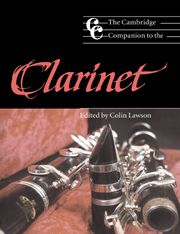Book contents
- Frontmatter
- 1 Single reeds before 1750
- 2 The development of the clarinet
- 3 The clarinet family
- 4 The development of the clarinet repertoire
- 5 Players and composers
- 6 The mechanics of playing the clarinet
- 7 Teaching the clarinet
- 8 Playing historical clarinets
- 9 The professional clarinettist
- 10 The contemporary clarinet
- 11 The clarinet in jazz
- 12 The clarinet on record
- Notes
- Appendices
- Select bibliography
- Index
6 - The mechanics of playing the clarinet
Published online by Cambridge University Press: 28 September 2011
- Frontmatter
- 1 Single reeds before 1750
- 2 The development of the clarinet
- 3 The clarinet family
- 4 The development of the clarinet repertoire
- 5 Players and composers
- 6 The mechanics of playing the clarinet
- 7 Teaching the clarinet
- 8 Playing historical clarinets
- 9 The professional clarinettist
- 10 The contemporary clarinet
- 11 The clarinet in jazz
- 12 The clarinet on record
- Notes
- Appendices
- Select bibliography
- Index
Summary
Introduction
I was given my first clarinet by my parents as a Christmas present, when I was nine years old. I remember taking it out of its case, and putting it together for the first time. The smell of the second-hand instrument was a particular delight – a sort of musty, oiled-wood smell, which went well with the sound I imagined it should have. We passed it around the family, everyone taking turns to try to get a tune out of it, and I was soon pleased to be able to do better than the others. It was mine, and I fell in love with it.
When I went to my very first teacher, Wilfred Kealey, he started to talk to me about music, and suggested ways of thinking which weren't directly related to the instrument, or even to the details of what I myself did. One thing which stuck in my mind was that I should imagine the clarinet sound as a smooth, round tube, which should begin deep inside me and stretch out through, and beyond, the bell of the instrument. It was my first encounter with a playing metaphor.
When we begin to play, we do think of the clarinet very much as an object – a very special object, perhaps, but nevertheless an object. It is an object that we must try to persuade to do what we want it to, and which often seems to resist us. So we are in the business of doing the right something to it in order to play well.
- Type
- Chapter
- Information
- The Cambridge Companion to the Clarinet , pp. 107 - 122Publisher: Cambridge University PressPrint publication year: 1995
- 2
- Cited by

